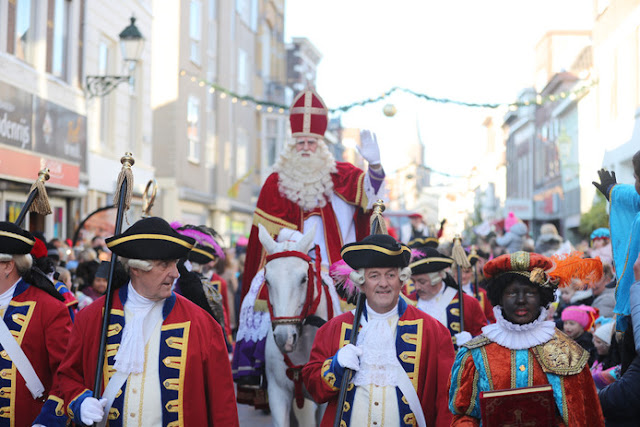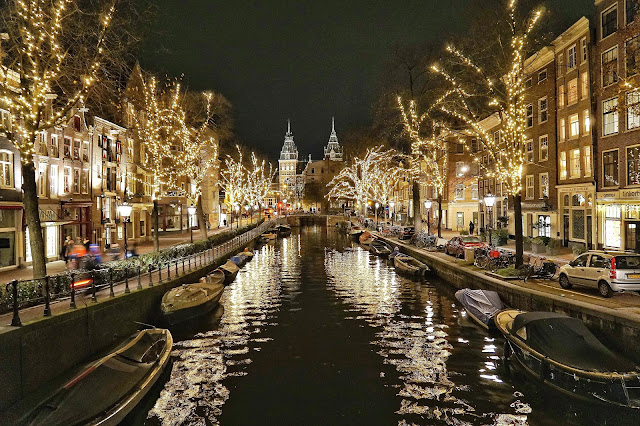
Christmas Caroling is either done door-to-door or in a collective meeting place for everyone to enjoy.

Its adaptability helped it endure. Our most-revered carols were written in fields and pubs... and then brought into churches. In many cases, lyrics written in one century got miraculously paired with music composed in another century--almost as if by divine intervention. "Angels From the Realm of Glory" shares the same melody as "Angels We Have Heard on High". Dunster Carols and Sheffield Carols predate modern carols: e.g.: "Hark! Hark What News", "A Song For the Time", and "Back Lane".
Caroling began during pre-Christian times. Thousands of years before Jesus Christ, pagans celebrated the Winter Solstice and gave thanks to Mother Nature for their land and harvests. To bolster winter doldrums, they marched to their orchards/farms and "gave back" some of their harvest...
... and then sang heart-warming songs.
Think of the words from "We Wish You A Merry Christmas", where the singers won't leave until they get figgy pudding. That routine somehow also got attached to Halloween as "Trick or Treat", where they don't leave until getting food.
For centuries, wassail bowls were popular across Europe, and a bearded godlike figure was associated with them... who looks like Santa Claus (or Odin, or Sinterklaas).
In Charles Dickens' A Christmas Carol, Ebenezer Scrooge's nephew has a Wassail Bowl.
Christians and pagans still enjoy wassailing nowadays!
The enduring drink, called Wassail, is currently popular.
Naturally, when Christianity came to the forefront, it preserved pre-existing holidays as a recruitment tool. It moved Jesus' summertime birthdate to December, so the festivities could remain in everyone's calendars.
The word "wassailing" was replaced by the French word "carole", which meant "song & dance". The fun of caroling endured centuries and continues to enliven our hearts. After initially being embraced by Christianity, such jolly tunes were banned by the Catholic Church in the 700s, in favor of somber chantings. Later, the Vatican exercised its domination over international authorities, and it outlawed all types of singing. In 13th-century Italy, St. Francis of Assisi persuaded the Church to get people enthusiastic about Christ through lively songs. Henceforth, choir memberships soared. Such customs continued for the rest of the Medieval Ages.
In the 1500s Tudor-era England (the end of the Medieval period), the citizenry was enamored with Christmas caroling and feasting during the holiday. Begun by the pagans of Northern Europe, the English maintained the decorative habit of hanging branches of evergreens and holly inside their homes. That era produced carols like "The Coventry Carol" (about King Herod massacring all infants, as he hoped to eliminate Baby Jesus) and "Tomorrow Will Be My Dancing Day".
As Puritans and Pilgrims rose to power in the 1500s, they opted to remove all ornamentation and merriment from churches: stained glass, pipe organs, precious metals, hymns, and carols. Oliver Cromwell supported his English government's laws against all religious holidays, yet he privately loved singalongs and dancing. "Adeste Fidelis"--a.k.a.: "O Come All Ye Faithful"--emerged from that time, and it's believed to carry an encrypted message about the coming of a new King of England. The song is now sung in every branch of Christianity. In 1620, the Pilgrims were banished to North America: the New World. (Maybe that explains the anti-sin strictness of America's "Bible Belt", but it also dampens the prestige of Mayflower Families who boast as America's oldest families). The Puritans were ousted from power, after that.
Carols were not forced upon people; they were songs that people wanted to sing so much that the psalm-chanting Church was forced to allow them in again. Humans have always enjoyed singing, and singing makes you feel good.
A personal favorite, "God Rest Ye Merry Gentlemen" originated in the 1600s and exists in many versions. In those days, lyrics were often mixed with various, local folksongs, as well as different tempos. During the next century, church choirs used musicians and singers who also performed at local taverns. It gave an upbeat air to caroling.
In the 1800s, churches sought every opportunity to preach the gospels--especially via hymns and carols. Baptists and Methodists (who loved communal singing) successfully published their own hymnbooks, followed by the Anglicans. It introduced standardized carols for everyone to learn.
That era produced "Once in Royal David's City", which was written by an Anglo-Irish woman named Cecil Frances Alexander. Another favorite is "The Holly and The Ivy".
The resumed notion of wassailing in different parts of the neighborhood was a boost for Christmas Caroling. It bred the notions of Hospitality and Spreading Good Cheer.
It was also the birth of a religious service called Lessons & Carols, which Lewis and I adore. In 1879, Bishop Edward W. Benson wanted to showcase his new Truro Cathedral on Christmas Eve. (Later, he became Archbishop of Canterbury). *[Lewis and I met the 104th Archbishop of Canterbury when he presided at NYC's Saint Thomas Church Fifth Avenue in 2017].
To keep revelers sober until the Midnight Mass, he created A Festival of Nine Lessons & Carols, which drew parishioners away from the pubs. It drew people of all faiths to enjoy the singing! It was Britain's first caroling service, and it is still enthusiastically performed around the world. It summarizes scripture and epistles--from Adam & Eve to Jesus' prophesied birth. The volunteers who offer those readings ascend the church's hierarchy: from a chorister to the rector (or bishop).
As I mentioned earlier, another fascinating aspect of Christmas carols is how they came into being. One of Lewis' favorite carols, "Ding Dong Merrily On High" got its melody from a French Renaissance dance tune named "Branle de l'Official", published in the 1500s. The lyrics and music sound like they were always meant to be together!
During the 1500s, the melody for "While Shepards Watched Their Flocks By Night" was composed, but it had different words (to please the killjoy Reformation). The words that we recognize today were given to it in the 1690s. It was a perfect match.
Written by hymn-maker, Charles Wesley in 1739, "Hark! The Herald Angels Sing" had different words, lacked angels, and its melody was different. Twenty years later, his friend, George Whitefield (also his protégée in forming the Methodist religion), improved the lyrics to its current form. The tune that we know was given to the song after composer, Felix Mendelssohn, met a choirboy William Cummings in 1847. That encouraged Cummings to mature into an abbey organist. In 1856, Cummings realized that the melody of Mendelssohn's "Chorus in G" was perfect for "Hark! The Herald Angels Sing". Henceforth, the song was performed that way.
"O Little Town of Bethlehem" was invented in the 1860s by a Philadelphia rector named Phillips Brooks, who visited Bethlehem. Initially, it was a poem. However, in Britain in 1903, Ralph Vaughn Williams--a lover of folksongs--met Henry Garmen, a tavern singer in Surrey, who sang "The Plowboys Dream". Williams applied that melody to Brooks' poem... and history was made!
Technically, most Christmas music is played during the liturgical season of Advent. According to the Church, Christmastime starts after Vespers on Christmas Eve, and it extends for 12 days, until Epiphany. Therefore, "The 12 Days of Christmas" is a perfect Christmas carol! Originating in France in the late 700s (during the reign of Charlemagne), the song came to England in the 1770s as a memory-or-forfeits game. Despite its danceable melody, an opera singer named Frederic Austin tweaked the song in 1909 to include its dramatic part about "Five Golden Rings".
*To see our Christmasy experiences in Berlin, Germany, please use this link:
In 1949, Gene Autry and his singing cowboys made the new tune "Rudolph the Red-Nosed Reindeer" hugely popular. In 1952, a 12-year-old prepubertal boy from Mississippi, named Jimmy Boyd, made the first recording of "I Saw Mommy Kissing Santa Claus". As you can see, humble beginnings can produce wonderful results... akin to the story of Christ's birth.
Most importantly, Christmastime is about helping those who are "in need". In many cases, Christmas carols have that message. As you sing some, may your heart be full of charity, gratitude, and joy!

























































































































































































































































































